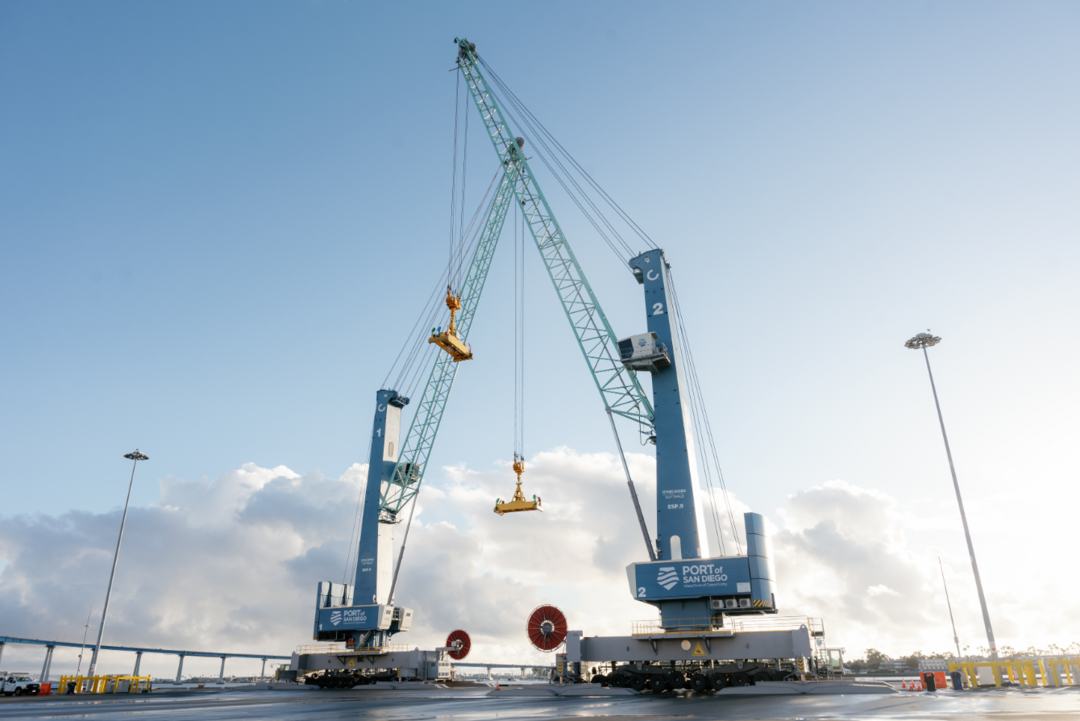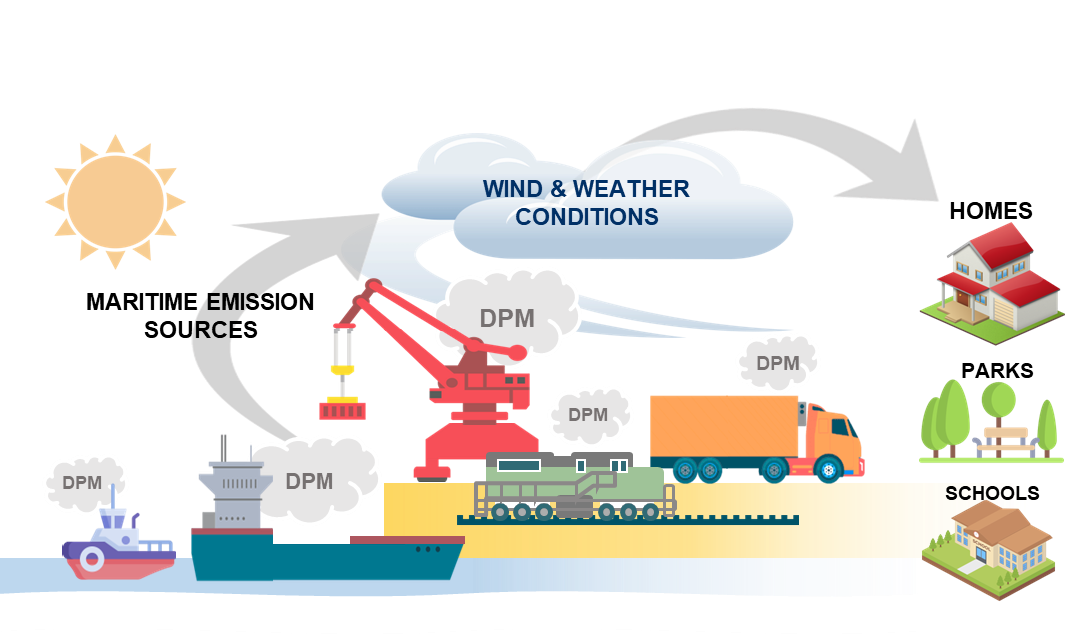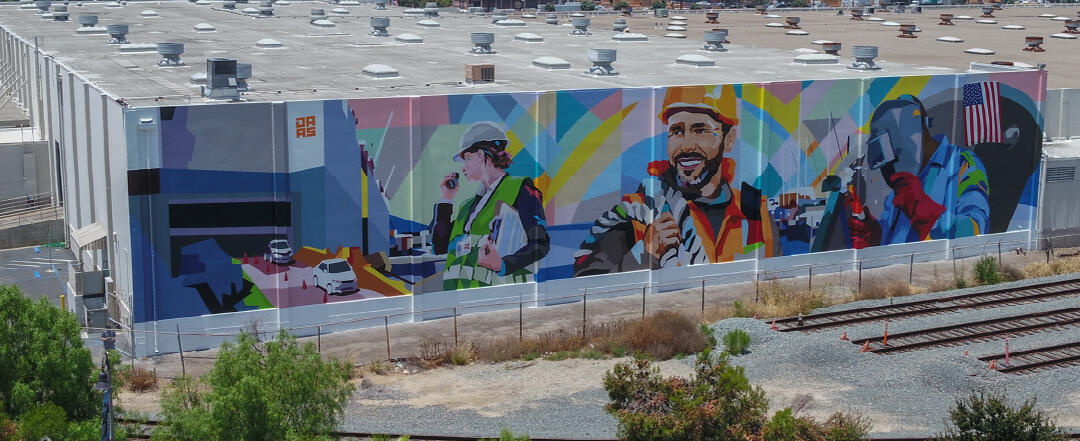What is the Maritime Clean Air Strategy?
On October 12, 2021, the Port of San Diego Board of Port Commissioners approved the Maritime Clean Air Strategy (MCAS) to help the Port identify future projects and initiatives to improve environmental and public health through cleaner air for all who live, work, and play on and around San Diego Bay while also supporting efficient, modern and sustainable maritime operations. The Maritime Clean Air Strategy’s vision, “Health Equity for All,” represents the Port’s commitment to environmental justice, technological innovation, and transparent governance. The MCAS is the most ambitious clean air strategy policy document of its kind in the State of California and , if achieved, it would represent emission reductions that go beyond current State regulations and policies.
View the MCAS Here Current HIGHLIGHTS Spanish Highlights
As an update to the Port’s 2007 Clean Air Program, the MCAS identifies ambitious long-term goals for 2030 with near-term emissions reduction goals and objectives to be accomplished by June 30, 2026. Collectively the MCAS identifies approximately 34 potential projects, partnerships, initiatives, and/or studies for seven sources of emissions. The MCAS not only documents the Port’s commitment to clean, modern, and sustainable maritime and goods movement operations, it also addresses three stakeholder driven priorities and supports public education and community empowerment efforts advanced as part of the Portside Community AB 617 Community Emissions Reduction Plan (CERP) administered by the San Diego Air Pollution Control District (SDAPCD).
Signature MCAS goals and/or objectives that go beyond State regulatory requirements include:
- A goal of 100 percent of cargo trucks calling on the Port of San Diego cargo maritime terminals being zero emissions (ZE) vehicles by 2030.
- A goal of 40 percent of cargo trucks calling on the Port of San Diego cargo maritime terminals being ZE vehicles by June 30, 2026.
- A goal of 100 percent of cargo handling equipment being ZE by 2030.
-
Facilitate implementation of the first all-electric tugboat in the United States by June 30, 2026.
Questions or comments on the MCAS? Please email Port staff at: mcas@portofsandiego.org
MCAS Checkpoint
Thank you to everyone that was able to join us for one of the MCAS Checkpoint community conversations! If you weren't able to make it, don't worry! You can view the same presentation given during the meetings at the link below. In the video, our Port subject matter experts explain the positive impact the Maritime Clean Air Strategy has made by improving local air quality and reducing air emissions as well as what the future holds from the program.
Survey: Thank you to everyone who completed our survey! The project team will use all community feedback received to help refine the MCAS, which will be presented to the Board for further discussion and direction in 2026.

Clean Cargo Project
In alignment with the MCAS, the Port is implementing the San Diego Clean Cargo Project. This $86 million project invests in clean air, electricity, and healthier communities. Funded in part by a $59 million grant under the U.S. Environmental Protection Agency’s Clean Ports Program, it will help the Port reduce harmful air emissions from maritime operations with the deployment of cutting-edge technology to electrify the Port’s two cargo terminals. It will also help create local workforce opportunities through training and implementation of clean tech infrastructure and positions the Port of San Diego as a model for sustainable goods movement nationwide. An additional $28 million in matching funds are provided by the Port, San Diego Air Pollution Control District (APCD), Dole, PASHA, Skycharger, and SSA Marine.
Project components include:
- Infrastructure Upgrades: Complete 12-kV electrical distribution system upgrades at the Tenth Avenue Marine Terminal (TAMT) to support zero-emission equipment and shore power.
- Shore Power Systems: Two systems for commercial harbor craft at TAMT and deployed throughout San Diego Bay and one system for ocean-going vessels at TAMT.
- Advance a proposed zero-emissions truck hub: Strategically located along the Tidelands Avenue truck route to serve both cargo terminals.
- Zero-Emissions Equipment and Vehicles, and Supply Equipment: Purchase and deployment of 32 battery-electric cargo handling equipment, 20 stevedore-shuttle vans, 25 heavy-duty trucks, and the electric vehicle supply equipment (EVSE) required for charging.
Additionally, the Environmental Health Coalition (EHC), a local environmental justice organization, has agreed to partner with the Port to conduct community outreach about the project. $400,000 in funding has been designated for community engagement that will be conducted during the four-year project period. The Clean Cargo Project also includes workforce development efforts. $500,000 has been budgeted for this purpose, to be spent during the four-year project to foster high-quality, family-sustaining jobs within port communities while expanding access to training and employment opportunities for individuals in low income and disadvantaged areas nearby.
EMISSION SOURCES:
-
Cargo Handling EquipmentCargo Handling Equipment
Cargo handling equipment is used to support terminal activities and move cargo on and off ocean-going vessels, harbor craft, rail, and trucks. Cargo handling equipment is necessary for coastal dependent maritime trade operations and water-based commerce. Based on the 2019 MCAS Emissions Inventory, the 20 highest emitting cargo handling equipment pieces are all located at the Tenth Avenue Marine Terminal (TAMT). If they were to be replaced with zero emission alternatives, the emission reduction objectives identified below could be attained.
It should be noted that not all 20 pieces of equipment are the oldest or dirtiest; rather, some of this equipment is simply used at a high, continuous frequency, and the emissions associated with this activity would be eliminated if replaced with zero emission alternatives. Additionally, not all 20 of the highest emitting cargo handling equipment pieces are owned by the Port of San Diego, but rather, are owned by terminal tenants or labor service providers, therefore coordination and collaboration with these partners is critical to achieving the zero emissions cargo handling equipment goals.
-
Commercial Harbor CraftCommercial Harbor Craft
Commercial Harbor Craft includes a variety of vessel and boat types that serve many functions within and near San Diego Bay including crew and supply boats, charter fishing vessels, commercial fishing vessels, ferry and excursion vessels, pilot vessels, towboats, tugboats, barges, and work boats. During the next five years, the Port will research, propose, and implement initiatives to assist vessel and facility owners and operators with the installation of zero and near zero emission infrastructure and equipment to meet or beat state goals. The Port is currently facilitating implementation of the first all-electric tugboat in the nation.
-
ShipyardsShipyards
Several shipyard facilities are located along the working waterfront and are regulated by two agencies. The California Air Resources board (CARB) regulates most off-road mobile equipment (sources) used at these facilities. The San Diego Air Pollution Control District (APCD) regulates stationary emission sources, such as emergency generators and welding and coating operations that result from ship-repair and construction related work.
Shipyards are subject to a number of Federal, State, and local regulations designed to reduce emissions. In California, the Clean Air Act compliance is a shared responsibility between the Environmental Protection Agency (EPA),CARB, and the local air pollution control agency. Under this framework, the San Diego Air Pollution Control District (SDAPCD is the local agency with authority for issuing air pollution control permits to stationary sources. SDAPCD also regularly inspects shipyards and other facilities holding air pollution control permits to verify compliance with permit conditions, emission limits, and applicable prohibitory rules. Shipyards rely on a variety of contractors and subcontractors to perform certain work, therefore they contain different activities and equipment along with different permits and regulations at each facility.
-
Heavy Duty TrucksHeavy Duty Trucks
Heavy duty trucks are used to transport cargo to and from the Port’s two marine cargo terminals. CARB recently adopted the Advanced Clean fleets Regulation which aims to transition heavy-duty trucks to zero emissions over the next two decades. The MCAS seeks to accelerate the transition to zero emission trucks by 2030—well in advance of state requirements.
-
Port of San Diego FleetPort of San Diego Fleet
The Port’s fleet of vehicles, equipment, and vessels are used by Port employees to carry out the management of the Port and the Tidelands.
Most vehicles operated by the Port are medium-duty vehicles such as typical work trucks. The MCAS aims to update its relevant purchasing and procurement policies to support investments in ZE/NZE emission technologies and create a ZE vehicle transition plan. The plan would identify a long-term schedule to phase out current vehicles and equipment and replace them with ZE alternatives.
The Port will continue to partner with SDG&E to install charging infrastructure on Port Tidelands, regional destinations and other locations throughout the western United States.
-
Ocean Going VesselsOcean Going VesselsUnderwater Noise Fact Sheet
Ocean Going Vessels (vessels greater than 10,000 gross tons or 400 feet in length), support the Port’s commercial maritime businesses at Tenth Avenue Marine Terminal, National City Marine Terminal and Broadway and B Street Cruise Terminal. In order to reduce emissions from these large vessels, the MCAS proposes to reduce in-transit emissions by facilitating the use of cleaner engines and fuels and recognizing participants in Port of San Diego’s Vessel Speed Reduction Program.
The Vessel Speed Reduction Program is a voluntary strategy to reduce air pollutants and greenhouse gas emissions from vessels by reducing speeds in the vicinity of San Diego Bay. Studies show reducing vessel speeds decreases air emissions which ultimately lead to better air quality. Reduced speeds can also reduce propeller noise, which provides an added benefit to the marine eco system. Shore power and carbon capture capabilities will also be expanded at commercial wharves to allow ships to emit less emissions while at berth.
Click for VOLUNTARY VESSEL SPEED REDUCTION PROGRAM PARTICIPATION SUMMARY REPORT
-
RailRail
Rail locomotives carry freight cargo between the Port’s two marine cargo terminals and regional destinations and/or to farther locations in the western United States. Freight rail service is provided exclusively by Burlington Northern Santa Fe (BNSF) Railway, which has direct access to the TAMT and the NCMT. BNSF is not a tenant on either of the terminals, nor do they require a coastal development permit to operate, therefore the Port has no jurisdiction and limited influence over rail operations. Nevertheless, operational improvements, including rail reconfiguration at TAMT, and shifting from the Tier 0 railcar switcher at the railyard to a near-zero or zero emissions railcar switcher at the rail yard, would significantly reduce freight rail emissions.
Rail upgrades have already begun with the completion of the rail lubricator and air compressor improvements on Tenth Avenue Marine Terminal as part of the TIGER Project. In addition, encouraging the use of cleaner switchers can also help reduce emissions associated with rail operations.
STAKEHOLDER PRIORITIES:
-
Community EnrichmentCommunity Enrichment
The Port is committed to working on implementing measures designed to reduce the cumulative environmental health burdens on Portside Communities that are attributable to adjacent industrial, maritime, and transportation uses and operations to ensure fair treatment of people of all races, cultures, and incomes. The MCAS Community Enrichment Goal and Objectives can help the Port address some of the Portside Communities historic environmental injustices through meaningful and frequent engagement. This includes greater opportunities to participate in the Port’s planning and public involvement processes, support for additional recreational and outdoor educational opportunities, and enhanced collaboration to reduce pollution and improve the physical condition of the communities.
-
Public HealthPublic HealthClick to view Health Risk Assessment (HRA)
The Portside Community has some of the poorest air quality in San Diego County. Polluted air can contribute to higher rates of asthma, cardiovascular disease, and a variety of other health related impacts. These health impacts are often exacerbated by socioeconomic factors, including poverty, educational attainment, unemployment, language barriers, and housing burdens—all of which are prevalent in the Portside Community.
Multiple sources contribute to the Portside Community’s poor air quality, including freeway traffic, industrial/ manufacturing facilities, gas stations, and off-road mobile sources, such as oceangoing vessels and other diesel equipment.
The Port is committed to reducing diesel emissions at its two marine cargo terminals in collaboration with tenants and other stakeholders. To better understand the health risks presented by emissions emanating from the marine terminals, the Port prepared a Health Risk Assessment consistent with Health Objective 1 of the MCAS. -
EnablingEnabling
The Port has several tools to achieve the goals and objectives of the MCAS. Well established practices include establishing voluntary programs, supporting regulatory efforts of other agencies, partnering on grant applications, providing financial incentives, and purchasing zero emission technology for its own fleet and equipment, and implementing emission reduction projects.
From a technological and infrastructure perspective, the emergence of new technologies and understanding locational limitations for infrastructure development are key considerations when it comes to identifying potential projects that meet MCAS goals and objectives.
MCAS Health Risk Assessment
As part of the Port of San Diego’s Maritime Clean Air Strategy (MCAS), a Health Risk Assessment (HRA) has been prepared in accordance with Health Objective 1, which directs staff to identify existing health risk levels generated from the Tenth Avenue Marine Terminal (TAMT) and the National City Marine Terminal (NCMT) for Diesel Particulate matter (DPM) and other Toxic Air Contaminants (TACs). The HRA establishes a health risk baseline for the areas near and adjacent to the Port’s two marine cargo terminals based on their 2019 activity and operations. The HRA explains how some key emission reduction strategies identified in the MCAS may help reduce health-related impacts.
The Port’s MCAS Health Risk Assessment - click here
The Executive Summary - Spanish click HERE
The HRA Fact Sheet - Click HERE
HRA Fact Sheet - Spanish click HERE

AB 617 Community Air Protection Program
In 2018, the California Air Resources Board (CARB) established the Community Air Protection Program (or AB 617 Program), which tasks local air pollution control districts to work with communities to develop community-focused emission reduction programs. CARB selected the Portside Communities for air monitoring, which include the neighborhoods of Barrio Logan, West National City, Logan Heights, and Sherman Heights, as well as the Port’s Working Waterfront between the Tenth Avenue Marine Terminal and the National City Marine Terminal. CARB designated the Portside Community for a Community Emissions Reduction Plan (CERP) to focus and accelerate new actions that go beyond existing State and regional programs and provide reductions in air pollution emissions and exposure.
The San Diego Air Pollution Control District (SDAPCD) is responsible for implementing AB 617 and established the AB 617 Steering Committee whose members represent residents, agencies, industry, non-profits, and other pertinent stakeholders.
For additional information regarding the APCD’s CERP, please visit the Community Air Protection Program (AB 617) webpage.
MCAS Timeline
Board of Port Commissioners initiates development of the MCAS.
Port staff presents to the Board a recommended approach for completing the MCAS.
- 7/13 - Board identifies a vision for the MCAS, “Health Equity for All.”
- 7/16 - The San Diego APCD Board approves Phase II of Portside Community’s AB 617 CERP.
- 8/5 - Port releases Draft Revised MCAS for public review and feedback.
- 8/26 - Port holds Virtual Update to review changes made from the Discussion Draft of the MCAS to the Draft Revised MCAS.
- 10/12 - Board of Port Commissioners approves MCAS
- 10/14 - The California Air Resources Board approves the Community Emissions Reduction Program for the Portside Community in San Diego.
Vessel Speed Reduction Program adopted
Heavy-Duty Zero Emission Truck Transition Plan/Presentation to the Board
TAMT Microgrid Infrastructure Project
Shore power at B Street Cruise Ship Terminal
First all-electric mobile harbor cranes in North America arrived at the Tenth Avenue Marine Terminal.
First all-electric tugboat in the United States arrived at Crosby Street Pier.
First all-electric mobile harbor cranes in North America are in full operation.
